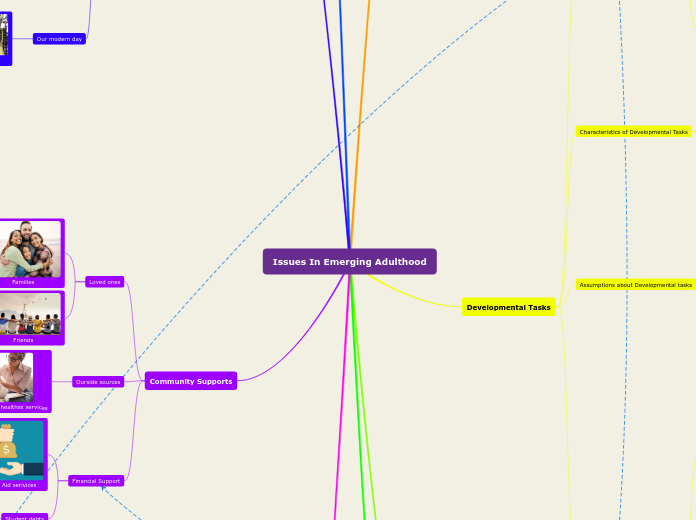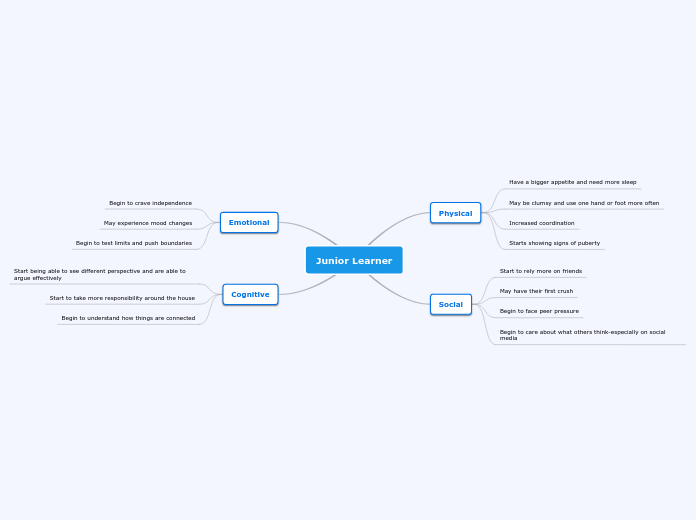Issues In Emerging Adulthood
Other
Racial Disrimination in the work force
Hispanic People
3.8% of all Hispanics are unemployed in America (Fitzgerald, 2019)
Asian People
South Asian
2.75% of all Souther Asian people are unemployed in America (Fitzgerald, 2019)
East Asian
2.5% of all East Asians in America are unemployed (Fitzgerald, 2019)
East asians face a lot of discimination today due to our current situation with the COVID-19 pandemic (Bowden, 2019)
Black people
Less likely to be accepted into prestigious post-secondary programs (Bowden 2020)
Colaborative programs such as Co-op (Bowden, 2020)
Ie: Yale, Harvard, Oxford (Bowden, 2020)
They are 45% less likely to be hired for a job due to their race "(Bowden, 2020)
Gender Inequality In the work force
#MeToo Movement
Less women maintain a job for over 5 years in a male dominated workplace (Began, 2018)
This can be for safety reasons (Began, 2018)
Less women are hired in male domianted office jobs (Began, 2018)
Some companies do this to "Minimize accusations" (Began, 2018)
Different career paths
Women are not hired often because they are steryotypically seen as "weaker" (Began, 2018)
Engeneering companies only hire about 10% of women (Began, 2018)
Identiy and Self Expression
Rise of the LGBTQ+ Community
Poor working environment for those in the LGBTQ+ community
53% Of members in the LGBTQ+ community reported hearing rude jokes targetted at them regarding their sexuality (Lesbian, Gay, Bisexual, and Transgender Workplace Issues: Quick Take, 2019)
LGBTQ people of color are 32% more likely to experience discrimination than white LGBTQ people (Lesbian, Gay, Bisexual, and Transgender Workplace Issues: Quick Take, 2019)
80% of the transgender population who were employed experienced harassment or mistreatment on the job (Lesbian, Gay, Bisexual, and Transgender Workplace Issues: Quick Take, 2019)
Milestones
Examples of Milestones
The expectation for individuals to accomplish tasks or skills by a certain age (Costa, 2020)
Expectations are set by social norms (Costa,2020)
What are Milestones?
an action or event marking a significant change or stage in development. (Whiting, 2018)
Other social issues
Decrease in the rate of marriage or meaningful relationships
37.8 % of Canadians got married by the end of (Highest and Lowest Canadian Divorce Rates By Profession, 2019)
Common Law couples make up 22% of households in Canada (Highest and Lowest Canadian Divorce Rates By Profession, 2019)
Divorce Rate is 38% In Canada (Highest and Lowest Canadian Divorce Rates By Profession, 2019)
Early Pregnancy
1 in 10 women drop out of post secondary due to an early pregnancy (Live births, by age of mother, 2020)
A mother would need to pick up a local job
Gender pay gaps
Canada has the 8th highest wage gap of 43 of the most developed countries in 2016 (The Facts about the Gender Pay Gap in Canada, 2018)
Women make $0.87 to every man's dollar (The Facts about the Gender Pay Gap in Canada, 2018)
Women make $.413 less per hour as of 2019 (The Facts about the Gender Pay Gap in Canada, 2018)
Community Supports
Financial Support
Student debts
OSAP
Financial Aid serivices
Ourside sources
Therapy and Mental healthss services
Loved ones
Friends
Families
History of Emerging Adulthood
Our modern day
21st Century
This time was described as "The extended period of adolescence (Costa, 2020)
Individuals during this time depend on this parents more often (Costa, 2020)
A decrease in employment prospects (Costa, 2020)
Less job opportunities
People spend more time on Post secondary education
More qualifications are needed each year
Causing a competitive job market
Credentials and having a higher education is often needed for a well paying job (Costa, 2020)
Adolescence tend to more in and out of their parent's homes (Costa, 2020)
This is an attempt at becoming more independent
They rely on their parents due to emotional issues (Costa, 2020)
More financial troubles
This can be due to student debts
WWI and WWII Era
20th Century
Life expectancy inceased
The unemployment rate deceased (Costa, 2020)
People got married earlier and worked to support their children (Costa, 2020)
More young adults were financially stable (Costa, 2020)
Women entered the workforce (Costa, 2020)
School was taken more seriously (Costa, 2020)
Children were encouraged to attend school rather than work (Costa, 2020)
School was considered mandatory until the age of 16 years old (Costa, 2020)
The main purpose of school was for kids to learn usefull skills that could be used later in life (Costa, 2020)
People would set goals for their educational progress (Costa, 2020)
WW1 and WWII caused children to go back to work at age 14 (Costa, 2020)
Child labour laws were put in place (Costa, 2020)
Children were no longer able to work at extremely young ages (under 14) (Costa, 2020)
Children began to hit puberty at ages 10-12 years old (Costa, 2020)
Industrialized Era
Later in the 19th century
Becoming independent was determined by how well a person could care for themselves and their future families (Costa, 2020)
Becoming a sexually mature individual was no longer an indication for marriage or independence (Costa, 2020)
On average, teens hit puberty at ages 16-18 years old (Costa, 2020)
Children got marreid at much younger ages (Costa, 2020)
This could be due to the deceased life expectancy (Costa, 2020)
Factory jobs allowed for more job opportunities (Costa, 2020)
Pre-industrial Era
1850's
Younger children often practiced skills that would help them later in adulthood (Costa, 2020)
Labour work
Caring for others
Cleaning
Cooking
There was a very high mortality rate during this time (Costa, 2020)
Financial unstable families sent children away to other families (Costa, 2020)
"Clocks" of Life
Social Clocks
Can be described as a timetable or schedule for life
These are expectations for one's own life (Costa, 2020)
This clock changes to meet the current social or societal norms (Costa, 2020)
Age of purchasing a home (Costa, 2020)
Age to start having kids (Costa, 2020)
Ie: Age to get married (2020)
Psychological clocks
How we mature Psychologically or mentally (Costa, 2020)
We gain a better understanding of how the world works (Costa, 2020)
The development of the brain
Biological Clocks
The physical changes and growth of a person (Costa, 2020)
Growth can happen faster (Costa, 2020)
Taking better care of yourself (Costa, 2020)
Physical Activity
Eating healthier
Puberty
Growing in strength
Growing in height (Costa, 2020)
Maturing Sexually (Costa, 2020)
Chronological clocks
Defines adulthood based on birth date (Costa, 2020)
Age regarding the legal system (Costa)
Voting age
Age of Majority
Depends on age
Applications of Theories
Leonard Pearlin's Theory of Psychological Deve;opment
He agreed with theories about how adulthood is a series of transitions from one period to another (Khanacademymedicine, 2014)
He attempted to explain how development can be different to each other (Khanacademymedicine, 2014)
Klaus Reigel's Theory of the Dimentions of Development
He states that adulthood occurs in unpredictable stages
Individuals learn to adjust and learn how to properly respond to these interactions (Khanacademymedicine, 2014)
These can be external or internal changes
Daniel Levinson's Theory of the seasons of life
Stage 2: age 22 - 28
Includes love, friendships, and values
This is where a person begins to settle down (Khanacademymedicine, 2014)
Stage 1 : age 17 - 22
Important for making future decisions
Ie : attending college, moving out, finding jobs, forming relationships (Khanacademymedicine, 2014)
Erik Erkison's Theory
Stage 6: Intimacy Vs. Isolation
Young adult, 18- 40 years old (Costa, 2020)
Stage 6: young adults at this are are able to form commitments and relationships. Partners are essential for a person’s development during this time (Kanacademymedicine, 2014)
Stage 5: Identity Vs. Confusion
Adolescence, 12- 18 years old (Costa, 2020)
Stage 5: Identity crises are common during this stage, people often explore to find their own views rather than going along with the views of their parents (Khanacademymedicine, 2014)
Issues in Emerging Adulthood
Mental Health
There has been a spike in mental health issues among young adults (Sagan, 2014)
Student Financial Aid
72% of all Students rely on financial aid such as OSAP to pay for school (Sagan, 2014)
Living in debt is negativity affecting the mental health of young adults (Sagan, 2014)
Causing depression and anxiety
44.4% of post secondary student reported having struggled with depressed or anxiety (Sagan, 2014)
This resulted in many students dropping out (Sagan, 2014)
As of 2019, Doug Ford cut OSAP funds drastically (Sagan, 2014)
Student Debt
The average Canadian student is in $32,600 by the age of 21 (Sagan, 2014)
On average, it takes 10 years for student loans to be paid off (Sagan, 2014)
Developmental Tasks
Development tasks throughout life
Adolescence
Academic achievements (Becoming An Adult, 2012)
Getting into Post-secondary schools
Improving learning skills
Successful transition into secondary school (Becoming An Adult, 2012)
Middle Childhood
Academic Achievements (Becoming An Adult, 2012)
Leaning to read and write well
Adjustment to a school environment (Becoming An Adult, 2012)
Self-control and discipline (Becoming An Adult, 2012)
Infancy/Preschool
Learning about themselves and their environment (Becoming An Adult, 2012)
Language development (Becoming An Adult, 2012)
Forming an attachment to the caregiver (Becoming An Adult, 2012)
Assumptions about Developmental tasks
Not accomplishing these duties within the required stage of life could lead to the inability to perform tasks that involve the next period or stage in life (Costa, 2020)
Developmental tasks are not the same as milestones since there is no specific moment that shows when each life task takes place (Costa, 2020)
A developmental task represents what society would consider to be normal development throughout the different points in the life span.
(Costa, 2020)
Characteristics of Developmental Tasks
Expectations are set by social norms (Costa, 2020)
Unsuccessful developmental tasks leads to inability to move forward to completing other developmental tasks later in life (Costa, 2020)
Something that is expected to have been achieved during a certain period of the lifecycle (Costa, 2020)
Difficult to determine when it was accomplished (Costa, 2020)
Examples of Devleopmental Tasks
Finishing school and graduating (Becoming An Adult, 2012)
Entering the workforce and starting a career (What are development tasks. 2016)
Additional Education/ Training (What are development tasks. 2016)
Finding a lifetime partner and getting married (What are development tasks. 2016)
Having kids and starting a family (Becoming An Adult, 2012)
Average age range is from 27-32 as of 2020 (Becoming An Adult, 2012)
Adulthood Defined
Common challenges
higher risk of being obese (A Portrait of Canadian Youth, 2017)
Caused by stress
mental health challenges and addiction (A Portrait of Canadian Youth, 2017)
cyberbullying (A Portrait of Canadian Youth, 2017)
social exclusion (A Portrait of Canadian Youth, 2017)
finding a full time job (A Portrait of Canadian Youth, 2017)
Today's adults are:
Tend to have a higher level of education (Painter, 2017)
More socially engaged (Painter, 2017)
More connected (Painter, 2017)
through social media
In person
More diverse (Painter, 2017)
Roles in adulthood
Live up to parental expectations (Painter, 2017)
Attend post secondary (Painter, 2017)
Work a part-time job (Painter, 2017)
Maintain a social life (Painter, 2017)
Care for themselves (Painter, 2017)
Emerging adulthood is a transition that begins
in adolescence and continues into adulthood. (A Portrait of Canadian Youth, 2017)
Adulthood is the period of life that follows
childhood and adolescence and lasts until death.
Therefore, adulthood begins when adolescence
ends. (A Portrait of Canadian Youth, 2017)









